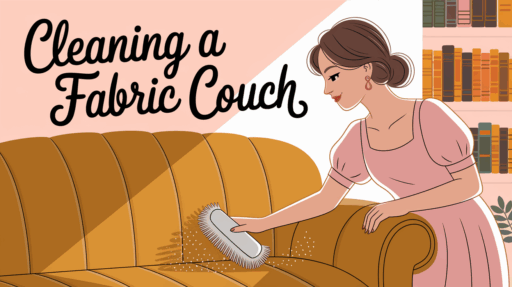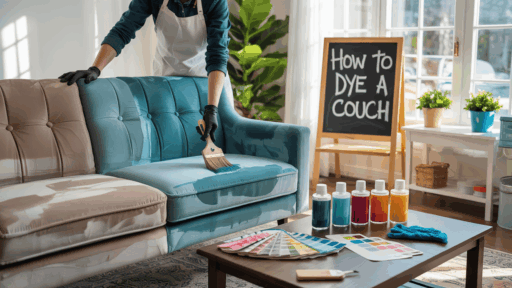Is your once-beautiful fabric couch looking tired and stained? Don’t worry – you’re not alone! Couches face daily battles with spills, pet hair, crumbs, and general wear.
Learning how to clean fabric couch properly can revitalize your living room and extend your furniture’s life without calling expensive professionals.
When dealing with mysterious stains from last week’s movie night or just wanting to freshen up your favorite lounging spot, you’ll find simple solutions here.
With simple household items and a little effort, your fabric couch can look and smell as good as new. Ready to bring back that showroom sparkle? Time to get started!
Why Cleaning Your Fabric Couch Is Essential
A clean fabric couch does more than just look good in your living room—it’s actually essential for your home’s health and comfort.
Over time, your couch collects dust, pet hair, food crumbs, and spills that can lead to unpleasant odors and stains. If left unchecked, these hidden particles can trigger allergies and even attract pests.
Regular cleaning extends the life of your furniture by preventing fabric breakdown and maintaining its color and texture. Plus, there’s nothing better than sinking into a fresh, clean couch after a long day! Many people forget about their couches during routine cleaning, focusing instead on floors and surfaces.
But considering how much time we spend lounging, napping, and entertaining on our couches, keeping them clean should be a priority.
With simple, regular maintenance, your fabric couch can stay looking and feeling great for years to come.
Understand Your Fabric

Understanding your couch’s fabric is the first step to cleaning it properly. Different materials need different care – cotton fabrics can usually handle water-based cleaners but may shrink if too wet, while polyester is more durable and stain-resistant.
Microfiber, though tough, requires special cleaning techniques to avoid water spots. To figure out what your couch is made of, check the tags or labels usually found under cushions or on the bottom of your couch.
These tags contain fabric care codes that tell you exactly how to clean safely.
- W: Use water-based cleaners like soapy water for a safe, gentle refresh.
- S: Stick to dry-cleaning solvents like alcohol to avoid water damage.
- WS: Choose either water-based or solvent cleaners for flexible cleaning.
- X: Vacuum or brush only—no liquids to protect delicate fabrics.
Following these codes is crucial – using the wrong cleaning method could permanently damage your furniture!
If you can’t find a tag, try contacting the manufacturer or testing any cleaning solution on a hidden spot first. Taking the time to identify your fabric type means you’ll clean effectively without causing damage.
Materials You’ll Need
Before tackling your couch-cleaning project, gather all the necessary supplies. Having the right tools on hand makes the job quicker and more effective.
Most items you’ll need are probably already in your home, but specialized tools like upholstery brushes may require a quick shopping trip.
- Firm bristle brush – Removes crumbs and loose dirt.
- Vacuum cleaner – Use with brush attachment for deep cleaning.
- Suitable cleaning solution – Choose based on your fabric type.
- Microfiber cloths – Perfect for blotting and drying.
- Baking soda – Great for deodorizing and absorbing odors.
- Dish soap – Helps tackle grease stains.
- White vinegar – Natural stain remover and deodorizer.
- Rubbing alcohol – Good for disinfecting and spot-cleaning.
- Spray bottle – For mixing and applying cleaning solutions.
- Old towels – Use for blotting excess water.
- Fan – Speeds up drying time.
- Lint roller or rubber glove – It effectively removes pet hair.
Total Estimated Cost Range
- For things like specialized brushes, cleaners, or a fan — $20 – $30
- If you need to buy a few additional tools or higher-end solutions — $50 – $100
Step-by-Step Guide to Clean Fabric Couch
Cleaning your fabric couch properly requires a step-by-step approach to ensure the best results. Following these steps in order will help you effectively remove dirt, stains, and odors. This method works for most fabric couches, but always check your specific fabric type first.
Step 1: Brush and Vacuum the Couch

Always start your couch cleaning with dry methods before using any liquids. Take your firm bristle brush and gently sweep it across the entire couch surface, including seams and crevices.
This loosens embedded dirt, crumbs, and pet hair that have settled into the fabric. Once you’ve brushed everything, switch to your vacuum with the brush attachment. Work systematically across the couch, paying special attention to the spaces between cushions and along seams where debris tends to collect.
Don’t rush this step – thorough vacuuming makes the rest of your cleaning process much more effective by removing particles that could become mud when wet.
Step 2: Spot Treat Stubborn Stains

After vacuuming, focus on any visible stains before moving to general cleaning. Check your couch’s fabric code and prepare the appropriate cleaner – water-based solutions for “W” fabrics, dry-cleaning solvents for “S” fabrics, or either for “WS” fabrics.
Before applying the cleaner to the stain, test it on a hidden area, like underneath the couch or behind a cushion, and wait a few minutes to ensure it doesn’t damage the fabric or cause color fading.
When treating the stain, apply a small amount of solution directly to a microfiber cloth (not the couch) and gently blot the stain from the outside toward the center. Never rub or scrub, as this can damage fibers and spread the stain further.
Step 3: Sprinkle Baking Soda for Deodorizing

Even clean-looking couches can harbor odors from daily use, pets, or food spills. Baking soda is perfect for neutralizing these smells naturally.
Once your stain treatments have dried, sprinkle a thin, even layer of baking soda across the entire couch, including cushions, armrests, and backrests. Don’t be afraid to use a generous amount for particularly smelly areas.
Let the baking soda sit undisturbed for at least 20-30 minutes, though you can leave it overnight for stronger odors. During this time, the baking soda absorbs odors and moisture from the fabric.
When time’s up, vacuum thoroughly, making multiple passes to collect all the powder.
Step 4: Deep Clean the Cushions

Removable cushions need special attention since they absorb the most dirt and body oils. First, check if your cushion covers have zippers – if so, carefully remove them and check the care label to see if they’re machine washable.
If machine-washable, use a gentle cycle with cold water and mild detergent, then air dry to prevent shrinking. For foam cushions that can’t go in the washer, fill your bathtub with warm water and a small amount of mild detergent, then gently hand-wash each cushion by pressing (not twisting) to release dirt.
Rinse thoroughly by pressing in clean water several times, then squeeze out excess water without wringing. Stand cushions on edge in a well-ventilated area to dry completely.
Step 5: Dry and Final Touches

Properly drying your couch is crucial to prevent mold, mildew, and water damage. Position a fan or two facing the couch to increase air circulation and speed up drying time.
For faster results, open windows if weather permits. While the couch dries, periodically fluff and rotate the cushions to ensure even drying and prevent moisture from settling in one area.
Once everything is completely dry, consider a light misting of rubbing alcohol in a spray bottle as a final disinfecting step – this evaporates quickly and kills remaining bacteria. Finally, return all cushions to their proper places, arranging them neatly and evenly for a fresh, clean appearance.
Video Tutorial – Watch How It’s Done
For more information, check out this video tutorial by Pro Housekeepers
Post-Cleaning Care
After putting in the work to clean your fabric couch, proper post-cleaning care ensures it stays fresh longer. Allow your couch to dry completely before using it again – this might take several hours or even overnight depending on how wet it got during cleaning.
Place fans nearby to speed up drying, but avoid direct heat sources like hair dryers or heaters, which can damage fabric fibers or set in stains.
Once dry, take time to refluff cushions by giving them a good shake, punching sides gently, and turning them over to help maintain their shape. This prevents uneven wear and extends the life of your couch.
Consider applying a fabric protector spray designed for furniture – these create an invisible barrier that repels liquids and prevents stains from setting deeply into the fabric.
Always test protector sprays on a hidden area first and apply according to package directions, usually in a thin, even layer while the fabric is completely dry. This extra step can save you significant cleaning time in the future.
Regular Maintenance Tips
Keeping your fabric couch clean is much easier with regular maintenance. Small, consistent efforts prevent dirt and grime from building up over time. These simple habits will help your couch stay fresh between deep cleanings.
- Vacuum your couch weekly using the brush attachment to remove dust and crumbs.
- Dust armrests and back areas with a microfiber cloth every few days.
- Blot spills immediately with a clean, dry cloth – never rub!
- Keep wet wipes nearby for quick spot-cleaning of small marks.
- Flip cushions monthly to ensure even wear.
- Rotate removable pillows and cushions every two weeks.
- Use washable throws on high-use areas to protect the fabric.
- Keep pets off the couch or use designated pet blankets.
- Avoid eating on your couch to prevent food stains.
Summing It Up
Now you know exactly how to clean fabric couches properly without expensive professional services. With these simple steps and regular maintenance, your couch can stay fresh, comfortable, and inviting for years to come.
Remember that quick action on spills and consistent care are your best weapons against stubborn stains and wear. Even the most neglected fabric couch can be revitalized with patience and the right techniques.
Best of all, most of what you need is probably already in your home! Next time you sink into your clean, fresh-smelling couch, you’ll be glad you took the time to care for this important piece of furniture.
Your home will feel more welcoming, and your furniture investment will last much longer!
If you’re interested in more DIY projects for your home, feel free to click here and explore our collection of easy weekend makeovers and step-by-step renovation tutorials.








